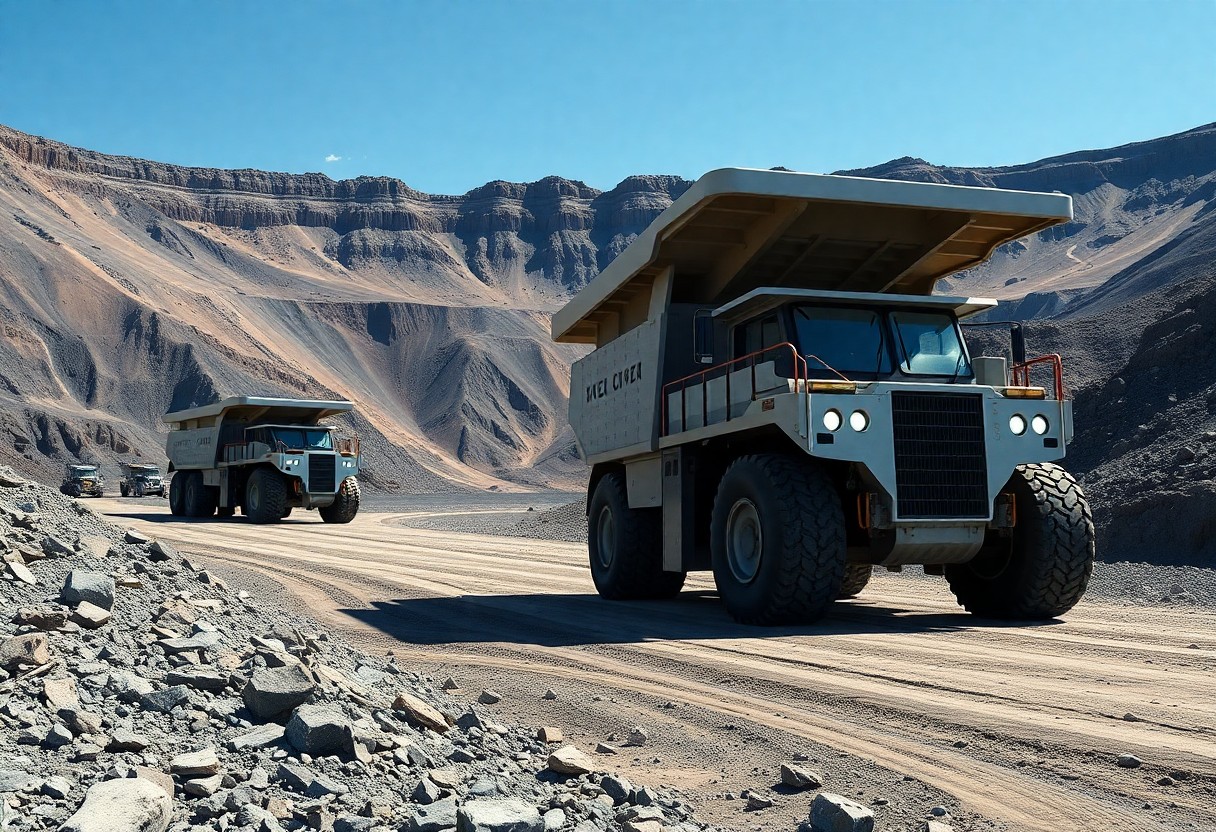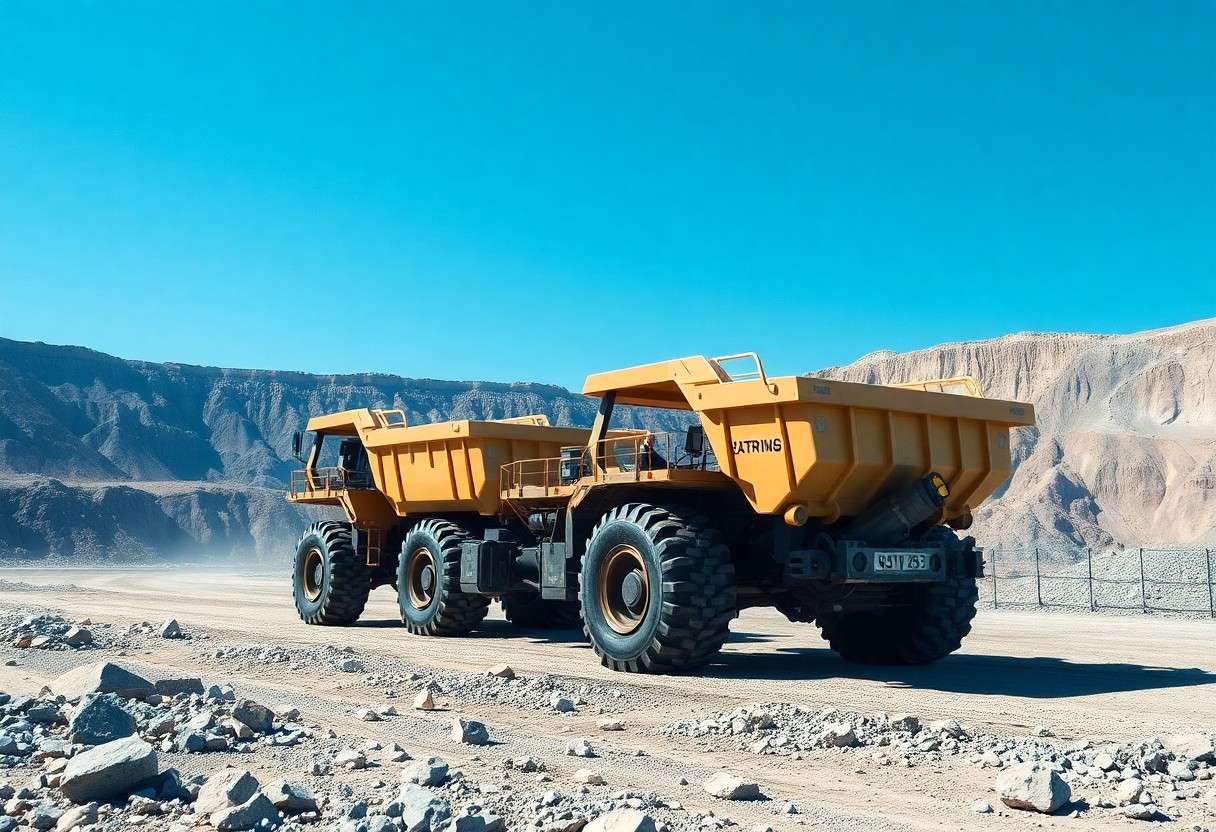You may be surprised to learn that Rio Tinto is at the forefront of innovation in the mining industry through its implementation of autonomous haulage systems. These advanced technologies promise to enhance operational efficiency and safety by reducing human error and potential workplace accidents. In this post, I’ll probe into how Rio Tinto’s partnerships with tech leaders are revolutionizing the way mining companies operate, while also addressing the environmental and economic advantages that these systems bring to the table. Get ready to explore the future of mining!
Key Takeaways:
- Rio Tinto is significantly invested in the development and implementation of autonomous haulage systems (AHS), showcasing its commitment to increasing operational efficiency and safety in mining operations.
- Collaborations with technology partners enhance Rio Tinto’s capacity to innovate, as they leverage advanced technologies such as artificial intelligence and data analytics to optimize the performance of autonomous trucks.
- The deployment of AHS aims to reduce environmental impact and improve productivity, aligning with Rio Tinto’s sustainability goals and the industry’s push towards modernizing mining practices.

Overview of Autonomous Haulage Systems
To understand the impact of autonomous haulage systems (AHS) in mining operations, it’s important to know what they entail. AHS incorporates advanced technology, including radar and GPS, to automate the process of transporting materials from one location to another within mining sites. This evolution in haulage enables vehicles to operate with minimal human intervention, enhancing efficiency and safety compared to traditional haulage systems where human operators are in control of heavy machinery. With options for both fully autonomous and semi-autonomous vehicles, AHS provides a versatile approach to manage high-volume transportation tasks effectively.
Definition and Functionality
On delving deeper into the functionality of AHS, you’ll discover that these systems comprise a series of interconnected technologies that facilitate real-time data collection and decision-making. Autonomous trucks rely on artificial intelligence to navigate routes, avoid obstacles, and communicate seamlessly with other vehicles and operational platforms. You’ll find that the integration of these systems allows for continuous data exchange, improving the overall coordination and productivity of mining operations.
Benefits for Mining Operations
Below the surface of these technological advancements lies a wealth of benefits that AHS brings to the mining industry. First and foremost, these systems can significantly reduce operational costs by minimizing the need for human drivers and associated labor costs. Furthermore, AHS enhances safety by removing personnel from potentially hazardous environments, thereby limiting exposure to dangerous conditions. As an added advantage, the operational hours can be extended without the constraints of human fatigue, leading to increased productivity long-term.
In fact, research indicates that companies implementing AHS have experienced a dramatic reduction in accidents and an improvement in overall logistical efficiency. With these systems working tirelessly, the risk of human error is diminished, allowing for a safer working environment. The data analytics provided by AHS also empower mining operations to optimize logistics and resource management, ultimately leading to improved yields. This multifaceted approach not only paves the way for safer working conditions but also enhances operational output, making AHS a transformative force in the mining industry.
Rio Tinto’s Approach to Autonomous Haulage
Clearly, Rio Tinto is at the forefront of integrating autonomous haulage systems within the mining sector. By embracing advanced technologies, they aim to revolutionize operational efficiency and enhance safety standards at their mining sites. This strategic shift not only aims to reduce costs but also to minimize the environmental footprint, ensuring a more sustainable approach to mining practices. I see this overwhelming focus on automation as a game-changer, not just for Rio Tinto but for the entire industry, as it pushes the boundaries of what is possible in mining operations.
Strategic Partnerships and Collaborations
About halfway through their mission to innovate mining practices, Rio Tinto has actively sought partnerships with tech leaders who specialize in autonomous technologies. These collaborations enhance their ability to deploy cutting-edge solutions efficiently. I believe that by leveraging the expertise of established companies with a proven track record in automation, Rio Tinto can accelerate the development and implementation of safer haulage systems in ways that would be hard to achieve independently.
Implementation in Key Mining Sites
One of the standout features of Rio Tinto’s approach to autonomous haulage is their deployment of these systems in their key mining operations, particularly in Australia. They have rolled out autonomous trucks in several of their mines, and the results have been quite telling: increased productivity and decreased operational risks. I find it particularly impressive how this technology works seamlessly to enhance performance while ensuring a safer work environment for personnel.
Strategic implementation of these autonomous systems in critical mining sites has demonstrated a sharp decline in the number of accidents involving heavy machinery. Additionally, the automation of haulage processes allows for round-the-clock operations, dramatically increasing efficiency. With the integration of these systems, you can expect Rio Tinto to achieve not only higher operational efficiency but also a significant reduction in labor costs, leading the way for the entire mining sector to explore similar paths toward innovation and sustainability.
Technology and Innovations
For those in the mining industry, the advent of autonomous haulage systems represents a groundbreaking shift in how we conduct operations. By embracing these technologies, I have witnessed firsthand the potential for increased productivity and reduced operational costs. The integration of autonomous vehicles not only streamlines the logistics of transporting materials but also offers unparalleled data analysis and processing capabilities, which enhance decision-making and efficiency across the board. With continuous advancements in technology, I am excited about how these innovations will shape the future of mining operations.
Software and Algorithms
Software is at the heart of autonomous haulage systems, transforming raw data into actionable insights. Advanced algorithms enable these systems to navigate complex mining environments, optimizing routes and managing time effectively. I find it fascinating how machine learning and artificial intelligence are employed to enhance these systems, continuously learning from each operation to refine performance and adapt to changing conditions. The sophistication of these software solutions highlights the ongoing evolution of technology in mining, making operations smarter and more reliable.
Safety and Efficiency Enhancements
Innovations in autonomous haulage systems are significantly elevating the safety and efficiency standards in mining operations. By deploying driverless trucks, fatalities and accidents associated with human error can be drastically reduced. I believe that these technological advancements not only protect our workforce but also ensure that operations run smoothly without compromising productivity levels. As these systems become more prevalent, I am confident that you will see a remarkable shift toward safer, more efficient mining practices.
A comprehensive focus on safety is embedded within the design of these systems. Autonomous vehicles are equipped with a range of sensors and cameras that provide real-time data, allowing them to detect obstacles and avoid potential hazards. This not only enhances worker safety but also optimizes fuel efficiency and minimizes environmental impact. The implementation of these technologies is reshaping the mining landscape, leading to safer working conditions and increased operational efficiency that can have lasting benefits for both companies and the communities they serve.
Case Studies
Despite the challenges inherent in implementing advanced technologies, the partnership between Rio Tinto and autonomous haulage systems has yielded impressive results across various mining projects. The following case studies illustrate the efficacy and impact of these systems:
- Pilbara Region, Australia: Rio Tinto has deployed approximately 100 autonomous trucks, leading to a 10% increase in operational efficiency and a remarkable reduction in costs by AUD 20 million annually.
- Granite Downing Operations: Implementation of autonomous haulage led to a 30% improvement in safety records, with a dramatic decrease in the incident rates associated with traditional haulage methods.
- Western Australia: The integration of autonomous systems in the mining fleet has facilitated a 15% reduction in fuel consumption, translating to both environmental benefits and significant savings on operational costs.
Successful Deployments in Mining Sites
At the forefront of innovation, Rio Tinto’s successful deployments in mining locations highlight the transformative potential of autonomous haulage systems. These systems have not only streamlined logistics and increased productivity but have also set a benchmark in safety practices. For instance, in the Pilbara region, the use of these autonomous trucks has allowed operators to maintain continuous operations while minimizing human error. This restructuring of traditional roles has empowered the workforce to focus on supervisory duties, thereby enhancing the overall oversight and management of mining activities.
Moreover, these technologies bring forth efficient asset utilization, as continuous data collection and analysis facilitate optimization of routes and loads. As a result, you will find that operations become more predictable, with real-time adjustments to fluctuating demands or unforeseen circumstances. By harnessing these advanced systems, Rio Tinto has not only positioned itself as a leader in the mining industry but has also set the stage for future expansions of automation within the sector.
Lessons Learned and Future Directions
Studies conducted on the integration of autonomous haulage systems at Rio Tinto illuminate valuable lessons for the wider mining industry. Initial pilot programs underscored the importance of gradual implementation and the need for comprehensive training programs to equip personnel with the necessary skills to manage these new technologies effectively. This incremental approach not only mitigates risks but also fosters acceptance among the workforce as they transition into more technology-driven roles.
Even as we reflect on the outcomes of these deployments, it is imperative to recognize the ongoing need for analysis and adaptation. The mining industry continues to evolve rapidly, and Rio Tinto’s experiences illustrate that staying ahead requires openness to new ideas and persistent innovation. Collectively, these lessons will guide future projects, ensuring that as technology advances, we are quick to adapt, making the most of the potential that autonomous systems have to offer. Additionally, focusing on the sustainability of operations is paramount; hence planning for environmental impacts and community engagement will remain the bedrock of future initiatives.

Challenges and Considerations
Not every aspect of implementing autonomous haulage systems comes without its challenges. Companies like Rio Tinto must navigate a landscape filled with uncertainties and potential roadblocks that can affect the efficiency and success of these technologies. For instance, regulatory compliance remains a significant factor, as local and international mining standards may lag behind technological advancements. Additionally, there are financial implications to consider, as the initial investments in infrastructure and technology can be substantial and may take time to recoup.
Technological Hurdles
Behind the allure of increased efficiency and safety lie several technological hurdles that must be overcome for autonomous haulage systems to function optimally. These autonomous vehicles rely heavily on sophisticated sensors, GPS technology, and data analysis algorithms. If any single component fails or experiences interference—be it from environmental conditions or physical obstacles—there is a risk of serious operational disruption. Furthermore, the complexities of integrating these systems with existing operations can lead to a steep learning curve, making it imperative for companies to engage in thorough planning and testing phases.
Workforce Impact and Training Needs
At the same time, the introduction of autonomous systems raises important questions about the workforce. As these technologies take over more manual tasks, the need for trained personnel who can manage, maintain, and troubleshoot them becomes evident. This transition likely means some existing positions may be phased out, while new roles focused on technology oversight emerge. Therefore, it is important to develop comprehensive training programs that equip current employees with the necessary skills to work alongside autonomous systems.
In addition, addressing the workforce impact involves creating pathways for workers to adapt rather than merely eliminating jobs. This could mean investing in education and reskilling initiatives to ensure employees can transition smoothly into new roles. By fostering a culture of continuous learning and adaptation, it’s possible to harness the benefits of autonomous haulage while also supporting your workforce in a changing landscape. Emphasizing these aspects can significantly enhance the overall acceptance of technological integration within your organization.
Future of Autonomous Haulage in Mining
Once again, the mining industry is on the brink of a technological revolution thanks to advancements in autonomous haulage systems. As companies like Rio Tinto continue to explore partnerships that enhance operational efficiency, we are witnessing a significant shift in how our resources are managed. These technologies not only promise to improve productivity but also aim to reduce operational costs and increase safety in hazardous work environments. As you consider the future landscape of mining, it’s important to understand the potential impacts these systems may have on various aspects of the industry.
Industry Trends
One key trend I’ve observed is the increasing integration of artificial intelligence and machine learning within autonomous mining operations. This allows haulage systems to adapt to changing conditions, optimizing routes in real-time and improving decision-making processes. Additionally, the movement towards sustainability is pushing companies to adopt technologies that minimize environmental impact. With regulations tightening globally, you may find that autonomous systems could play an crucial role in meeting these environmental standards while still maintaining high levels of productivity.
Predictions for the Next Decade
Future insights suggest that by 2033, the adoption of autonomous haulage systems in mining will not only be widespread but will also lead to a fundamental transformation in workforce dynamics. As these technologies become more sophisticated, operators will need to upskill or reskill to manage and maintain these systems effectively. I foresee a shift where human roles are more focused on oversight and strategic planning rather than traditional labor tasks.
Decade-long predictions indicate that as the mining sector embraces these innovations, there will be both opportunities for growth and challenges to face. The automation of haulage systems is expected to reduce accident rates, thereby enhancing worker safety. However, this transition also brings concerns regarding job displacement among manual laborers, highlighting the importance of implementing strategic workforce development programs alongside technological advancements. As we step into this new era, it’s vital for industry leaders to navigate these complexities carefully to achieve a balance between technological progress and human employment in the mining sector.
Final Words
Ultimately, I believe that partnering on autonomous haulage systems marks a significant advancement in the mining industry. This collaboration not only enhances operational efficiency but also emphasizes safety and sustainability in mining practices. By investing in innovative technologies, we can reshape traditional approaches, offering a promising future where automated systems transform the way you manage resources and reduce risks. As I explore more about these developments, I encourage you to check out the article on Rio Tinto to develop autonomous haulage solutions.
Moreover, the adoption of autonomous systems benefits not just the companies involved but also the entire mining ecosystem. As I share insights on this topic, it becomes clear that your engagement with automation can lead to improved productivity, reduced operational costs, and safer mining environments. I invite you to stay informed and consider how these changes might impact your approach to mining and resource management.
FAQ
Q: What are autonomous haulage systems, and how do they benefit mining operations?
A: Autonomous haulage systems (AHS) are automated technology solutions that allow trucks to transport materials without human intervention. These systems enhance operational efficiency by increasing the precision of load management and optimizing routes within mining sites. Benefits of AHS include higher productivity levels, reduced operational costs, improved safety due to the minimization of human error, and lower environmental impact through optimized fuel usage.
Q: How is Rio Tinto partnering with technology providers to implement autonomous haulage systems?
A: Rio Tinto collaborates with leading technology providers to design and deploy autonomous haulage solutions tailored to their mining operations. This partnership involves extensive research and development to ensure that AHS is seamlessly integrated into existing workflows. By sharing expertise and resources, Rio Tinto and its partners actively work to overcome challenges related to technology deployment, optimizing the entire mining process while maintaining safety protocols.
Q: What impact do autonomous haulage systems have on the workforce in the mining industry?
A: The implementation of autonomous haulage systems can significantly influence the mining workforce. While there may be concerns regarding job displacement, these systems also create opportunities for upskilling and reskilling workers. Personnel may transition to roles that focus on the operations and maintenance of advanced technology, as well as positions in data analysis and system management. Overall, AHS enhances the work environment by reducing the risks associated with manual operations and allows workers to focus on more strategic tasks.









